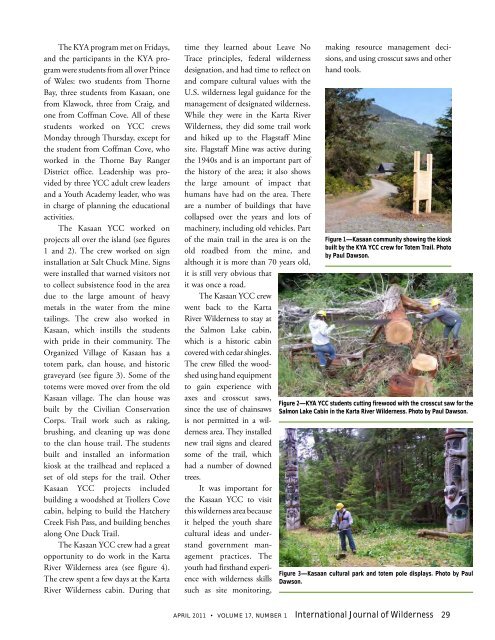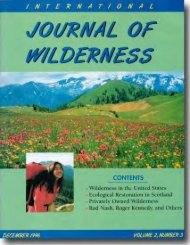Download April 2011 PDF - International Journal of Wilderness
Download April 2011 PDF - International Journal of Wilderness
Download April 2011 PDF - International Journal of Wilderness
You also want an ePaper? Increase the reach of your titles
YUMPU automatically turns print PDFs into web optimized ePapers that Google loves.
The KYA program met on Fridays,<br />
and the participants in the KYA program<br />
were students from all over Prince<br />
<strong>of</strong> Wales: two students from Thorne<br />
Bay, three students from Kasaan, one<br />
from Klawock, three from Craig, and<br />
one from C<strong>of</strong>fman Cove. All <strong>of</strong> these<br />
students worked on YCC crews<br />
Monday through Thursday, except for<br />
the student from C<strong>of</strong>fman Cove, who<br />
worked in the Thorne Bay Ranger<br />
District <strong>of</strong>fice. Leadership was provided<br />
by three YCC adult crew leaders<br />
and a Youth Academy leader, who was<br />
in charge <strong>of</strong> planning the educational<br />
activities.<br />
The Kasaan YCC worked on<br />
projects all over the island (see figures<br />
1 and 2). The crew worked on sign<br />
installation at Salt Chuck Mine. Signs<br />
were installed that warned visitors not<br />
to collect subsistence food in the area<br />
due to the large amount <strong>of</strong> heavy<br />
metals in the water from the mine<br />
tailings. The crew also worked in<br />
Kasaan, which instills the students<br />
with pride in their community. The<br />
Organized Village <strong>of</strong> Kasaan has a<br />
totem park, clan house, and historic<br />
graveyard (see figure 3). Some <strong>of</strong> the<br />
totems were moved over from the old<br />
Kasaan village. The clan house was<br />
built by the Civilian Conservation<br />
Corps. Trail work such as raking,<br />
brushing, and cleaning up was done<br />
to the clan house trail. The students<br />
built and installed an information<br />
kiosk at the trailhead and replaced a<br />
set <strong>of</strong> old steps for the trail. Other<br />
Kasaan YCC projects included<br />
building a woodshed at Trollers Cove<br />
cabin, helping to build the Hatchery<br />
Creek Fish Pass, and building benches<br />
along One Duck Trail.<br />
The Kasaan YCC crew had a great<br />
opportunity to do work in the Karta<br />
River <strong>Wilderness</strong> area (see figure 4).<br />
The crew spent a few days at the Karta<br />
River <strong>Wilderness</strong> cabin. During that<br />
time they learned about Leave No<br />
Trace principles, federal wilderness<br />
designation, and had time to reflect on<br />
and compare cultural values with the<br />
U.S. wilderness legal guidance for the<br />
management <strong>of</strong> designated wilderness.<br />
While they were in the Karta River<br />
<strong>Wilderness</strong>, they did some trail work<br />
and hiked up to the Flagstaff Mine<br />
site. Flagstaff Mine was active during<br />
the 1940s and is an important part <strong>of</strong><br />
the history <strong>of</strong> the area; it also shows<br />
the large amount <strong>of</strong> impact that<br />
humans have had on the area. There<br />
are a number <strong>of</strong> buildings that have<br />
collapsed over the years and lots <strong>of</strong><br />
machinery, including old vehicles. Part<br />
<strong>of</strong> the main trail in the area is on the<br />
old roadbed from the mine, and<br />
although it is more than 70 years old,<br />
it is still very obvious that<br />
it was once a road.<br />
The Kasaan YCC crew<br />
went back to the Karta<br />
River <strong>Wilderness</strong> to stay at<br />
the Salmon Lake cabin,<br />
which is a historic cabin<br />
covered with cedar shingles.<br />
The crew filled the woodshed<br />
using hand equipment<br />
to gain experience with<br />
axes and crosscut saws,<br />
since the use <strong>of</strong> chainsaws<br />
is not permitted in a wilderness<br />
area. They installed<br />
new trail signs and cleared<br />
some <strong>of</strong> the trail, which<br />
had a number <strong>of</strong> downed<br />
trees.<br />
It was important for<br />
the Kasaan YCC to visit<br />
this wilderness area because<br />
it helped the youth share<br />
cultural ideas and understand<br />
government management<br />
practices. The<br />
youth had firsthand experience<br />
with wilderness skills<br />
such as site monitoring,<br />
making resource management decisions,<br />
and using crosscut saws and other<br />
hand tools.<br />
Figure 1—Kasaan community showing the kiosk<br />
built by the KYA YCC crew for Totem Trail. Photo<br />
by Paul Dawson.<br />
Figure 2—KYA YCC students cutting firewood with the crosscut saw for the<br />
Salmon Lake Cabin in the Karta River <strong>Wilderness</strong>. Photo by Paul Dawson.<br />
Figure 3—Kasaan cultural park and totem pole displays. Photo by Paul<br />
Dawson.<br />
APRIL <strong>2011</strong> VOLUME 17, NUMBER 1 <strong>International</strong> <strong>Journal</strong> <strong>of</strong> <strong>Wilderness</strong> 29










